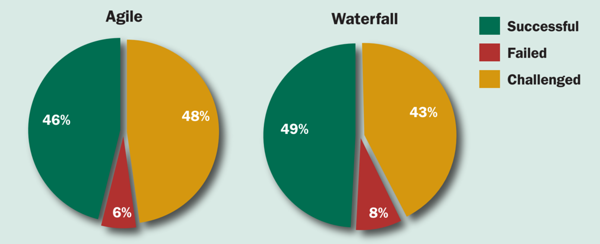September 27, 2018
Agile development? Test using the agile approach!
The process of redesigning your website has begun and you're planning to do it in agile mode. Whether it's being carried out internally or together with your web design agency, everything is ready and in place: the scrum master, the agile sprints, the test and learn approach. Or nearly everything that is. Because, bizarrely, you haven't planned as many tests as you have sprints.
This is an interesting paradox. More and more teams, just like yours, are turning to agile project management; but agile development does not necessarily rhyme with agile testing. Why is this? In this article we start from the principle that you already know that the end-user does not think like you do, and that's why you need to question them and ask them their opinion.
It's even more crucial to test your website when working in agile mode
In reality, projects undertaken in agile mode can be as much or even more susceptible to going awry in terms of either time or budget than more traditional projects (commonly referred to as waterfall or V-model projects). In fact, and according to the Chaos Manifesto 2013, as many as 48% of them go awry in this way, whereas with more traditional type projects the figure is 43% (the "challenged" part in yellow in the graphic below).
Testing will therefore still play a significantly important role in your project, even with a scrum master available:
-
To start with, we have one of the fundamental precepts of the agile manifesto: "Users or their representatives and developers must work together on a daily basis throughout the project."
-
The finish of each sprint is an opportunity to change the direction of the project for the better, on the condition that you collect the opinions of your future web visitors.
-
Next, agility requires that you remain open-minded about what constitutes the finished product; but how can you know when you've arrived at that point: what does success, i.e. a satisfactory outcome, actually look like? Given what's at stake in terms of the quality perceived by users, it's clear that you need to consider the deliverable products from the point of view of the web visitors.
-
Agile teams are multidisciplinary, and though this can prove to be richly advantageous, there can sometimes be a lack of a simple, external means through which to arbitrate the decision-making process. The views and opinions of clients play this role.
-
Finally, your team needs sound, solid, factual arguments in order to sell its decision to external stakeholders and the rest of the organization.
And anyway, it's not really possible to test your website every week, as our client Bayes Impact can testify.
Creating your website via a process of testing: the experience of one of our clients, Bayes Impact
Florian Jourda, who is in charge of the Bob Emploi product at Bayes Impact, explains in this video how he created his site by carrying out user tests every week and by:
-
taking advantage of the benefits of using less strictly organized tests
-
using weekends so that results would be made available by Monday
-
testing across the whole of France, with a representative population
Florian's team is clearly organized so that it can deliver new developments every week. Additionally, when they tested a new homepage and it turned out that users did not understand it at all, they immediately knew what they needed to correct.
Adopting an agile approach to the redesign of your website: the obstacles to testing
Despite the inspiring example of Bayes Impact, agile testing (potentially at each and every sprint) remains the exception. Why isn't more client testing carried out in agile mode? The answer lies in a mixture of assumptions and limitations that are specific to traditional qualitative studies:
-
Assumption: client tests will be limited exclusively to user-friendliness. This restrictive approach to user testing prevents you from asking your clients in advance about the products you plan to offer them. Yet there is nothing to stop you doing this long before you reach the design phase.
-
The need to organize face-to-face tests and their lack of flexibility means that incorporating them into sprints is excessively time-consuming. As we saw in Florian's account, this is no longer really a problem with user tests carried out remotely.
-
Recruitment difficulties: supposing you manage to question and get the views of a handful of people, does having the opinion of one, three or five individuals really prove anything? The answer is clearly yes. Even a small sample is better than carrying out no testing at all, as Steve Krug demonstrates in his book Don't Make Me Think. And the good news is that it's completely possible to increase the size of the sample without compromising on the quality or speed of the testing in any way.
Crowdtesting will help you test easily and simply using real people
Crowdtesting is based on two main principles:
-
the existence of a responsive and qualified community of users, which renders the recruitment phase redundant in most cases.
-
the use of technology to standardize the entire value chain provided by qualitative studies, with no compromise on quality.
Therefore, and whether it's together with your advertising agency or with your internal teams, you'll very easily be able to launch tests, and you'll be able to do so:
-
in a rapid manner, with it typically taking seven days from validating the interview guides to reviewing the results.
-
by testing from the initial conception phase through to the day before launch: it's never too late to learn from users, and it's especially never too soon!
-
by taking advantage of a greater variety of testing opportunities, particularly with respect to "small" tests: though certain phases warrant ambitious methodologies and samples consisting of dozens of people, it's sometimes important to be able to get simple answers that you can quickly take action about. To this end, it's possible to do as Bayes Impact did and test over the weekend, requesting only the views and opinions of a handful of users (between 5 and 15), or even to launch a survey to find out which of two agency-created versions users prefer straight after you come out of a meeting.
To learn more about testing when creating or redesigning a website, take a look at our solutions and find out more about what you can expect to get from user tests.
All articles from the category: User research user testing | RSS

